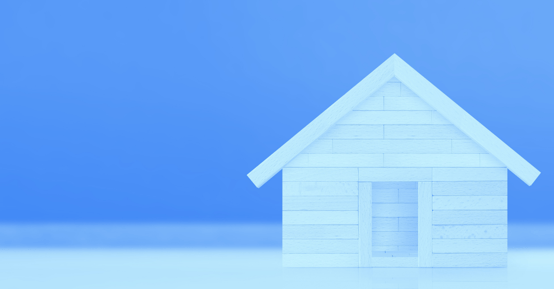How To Buy A Home When You Have Substantial Student Loan Debt
Share this

7 MIN READ
Buying a home is a big financial investment. It’s very likely the largest financial investment you have ever made. This is why I strongly recommend first challenging the belief that buying a home is always right for you. It’s critical that you fully weigh the pros and cons of making this financial investment and understand the opportunity cost of the down payment you are putting towards the home.
But let’s say you have fully thought it through and feel confident that buying a home in the near future is in fact aligned with your values and goals. How will your student loans impact this?
You may feel like having substantial student loan debt acts as a dark cloud over your ability to buy a home. However, with proper planning and understanding, you can easily purchase a home without making unnecessary financial sacrifices in the process. Here’s how.
How Student Loans Impact Your Ability To Qualify For a Mortgage
There are two critical variables that lenders focus on when determining your ability to qualify for a mortgage – your credit score and your debt to income ratio.
Your credit score is a numerical value that credit agencies give you to “score” your ability to pay back debt. A long-standing credit history, high credit limits and a strong repayment history (meaning minimal missed payments) will all result in a good credit score. The higher your credit score, the lower the risk to the lender of you defaulting on your debt and the better the mortgage terms you can receive. Your student loan balance doesn’t impact your credit score.
Your debt to income ratio takes your average monthly debt payments (car, credit card, student loans, etc.) and divides it by your average monthly income. The lower your debt to income ratio, the lower the risk to the lender of you defaulting on your debt and the better mortgage terms you can receive.
Surprisingly, your student loan balance is typically ignored by the lender and instead, the lender will use your actual monthly payment. In other words, if you have $200,000 of student loan debt and your current monthly payment is $500, it means the lender will typically only consider your $500 monthly payment when determining your debt to income ratio, not the $200,000 of student loan debt.
But why do lenders typically use your actual loan payment instead of your loan balance? When would they not?
As long as you are able to make a 5% down payment (which means the loan won’t be a Federal Housing Administration (FHA) loan) and your credit report shows an actual monthly payment on your loans, your monthly payment will be used, not the total balance. However, if you are unable to make a 5% down payment, then your loan will be an FHA loan and the lender will use the greater of your actual monthly payment or 1% of your total outstanding loan balance. Using the same example as before, this means the lender would use the 1% * $200,000 = $2,000 as a monthly payment instead of your $500 monthly payment. In turn, this increases your debt to income ratio which will negatively impact your ability to qualify for a mortgage.
Adjust Your Repayment Plan To Lower Your Student Loan Payments
Assuming you will have >5% saved up for a down payment, there are some unique planning strategies that you can implement leading up to when you want to buy a home to put yourself in the best position for a mortgage. Remember – the lower your student loan payment, the lower your debt to income ratio and the better mortgage terms you will receive. So how do you lower your student loan payment?
Assuming you have federal student loans, the best way to lower your monthly payment is to enroll in an income-based repayment plan. These plans are structured so you pay a specific percentage (typically between 10 – 15%) of your income after various deductions to your student loans on a monthly basis. In other words, similar to qualifying for a mortgage, your student loan balance is excluded from your calculated monthly payment.
When enrolling in an income-based repayment plan, you most commonly use your prior year’s tax return when certifying your income. For example, if your 2019 adjusted gross income was $150,000, then your student loan repayment calculation will be based upon $150,000 of income.
Now, let’s say you and your partner are planning to purchase a home in 2022. There are many ways that you could lower your income in 2021 for student loan purposes. Here are a few –
- Contribute to a pre-tax 401(k) or Traditional IRA (assuming you qualify) instead of a Roth 401(k) or Roth IRA. I usually strongly favor Roth savings over pre-tax savings, but not necessarily for people with high student loan debt. By contributing to pre-tax investment accounts, you can lower your income for 2021 which in turn will lower your reported student loan payment for 2022.
- Contribute to other pre-tax accounts like a Health Savings Account, Health Flexible Spending Account and Dependent Care Flexible Spending Account. These accounts are typically offered by employers that allow you to set aside pre-tax dollars for medical and dependent care expenses. Not only are you avoiding tax on the contributions, but you are also lowering your income to then lower your student loan payments.
- If you are married, consider filing taxes separately so you can exclude your spouse’s income (as long as you are not on Revised Pay As You Earn) from your student loan calculation. For example, if you earn $150,000 and your spouse earns $100,000, by filing taxes separately, you are lowering your monthly payment by at least $833 per month! This will significantly lower your debt to income ratio and put you in better position to qualify for a mortgage.
If buying a home is an important goal for you and your partner, it’s important to plan ahead and make sure you are making the appropriate adjustments to your student loans to put you in the best position to qualify for a mortgage. This also doesn’t have to be a long-term strategy for your loans. You could purposefully lower your income in 2021 so your student loan payments are lower in 2022 and then revert back to a different repayment strategy after receiving your mortgage. A lender is not going to look back and say “oh hey – never mind, you can’t have that mortgage since your student loans are higher now”. Almost all mortgages are sold after they are initiated so after you receive your mortgage, you can do whatever you want with your loans!
How Much to Save For a Down Payment
Your down payment is the initial amount that you pay towards your home. The most commonly recommended down payment is 20% of your home purchase price. Why 20%? This is the threshold that most lenders use so that you avoid private mortgage insurance (PMI). PMI is essentially an extra “fee” that you are paying because you took out a sizeable mortgage (>80% of the purchase price) and the lender believes the risk of you repaying the mortgage is higher.
While avoiding PMI is nice, I actually recommend at least a 20% down payment because it acts as a “gut check” as to whether you can afford the home. If you don’t have 20% saved up, then you may want to consider either lowering your purchase price or waiting longer to buy so you can save more.
As more and more people prioritize experiences (travel, food, hobbies, etc.) over things (home, cars, clothes, etc.), you don’t want to handcuff your ability to spend money on experiences because so much of your cash flow is going towards a big mortgage. I’ve seen firsthand how having a big mortgage dampens your ability to truly experience your money. Not having 20% saved up for a down payment is a great sign that your purchase price may be too high, or you don’t have enough savings right now.
Open a Separate House Savings Account
Let’s say you already have cash saved up or you are prioritizing your savings to build up your home down payment. I highly recommend opening a separate high-yield savings account that is named “house fund” so you can separate it from your other savings.
Having all of your cash in one checking or savings account can give a false sense of security that you have enough for a specific home down payment. The last thing you want to do is to use all of your cash for a large down payment and leave yourself with an insufficient emergency fund or the inability to complete renovations/buy new furniture for the new place.
For example, let’s say you have $100,000 of cash in your bank accounts right now and your average monthly spending is $10,000/month. This means you would want to have at least $30,000 of cash (3 months of expenses) at all times in what I like to call an “oh shit” emergency fund so that you enough to cover emergencies/unforeseen events and avoid going into credit card debt.
Therefore, your “true” amount to contribute towards a home down payment is $70,000, not $100,000. This is where you can open a specific house fund and transfer the existing $70,000 and future excess cash flow into this account. This type of mental and physical separation of money will help you stay disciplined in truly buying a home that is within your price range without leaving yourself cash poor.
Key Takeaways
- It is critical to plan ahead when you are planning to buy a home in the near future. Understanding the impact your student loans will have on qualifying for a mortgage and making proactive adjustments to your repayment strategy can put you in a much better position to qualify for a mortgage and receive more favorable terms when that time comes. Remember – you can always change your repayment strategy after you qualify for a mortgage!
- Don’t buy more house than you can afford. If you can’t afford a 20% down payment, it’s a clear sign that you either need to lower your targeted purchase price or wait longer to buy a home so you can save more. If you put less than 20% down, then you will likely find yourself paying PMI and feeling chained by a big monthly mortgage payment.
- Open a specific house savings account so you can separate your emergency fund from your house savings account. Be sure to leave enough wiggle room in your house savings account to fund closing costs, renovations and new furniture.
 About the Author
About the Author
Jake is the founder of Experience Your Wealth, LLC, a virtual, fixed-fee financial planning firm helping travel-loving, young families with student debt find the responsible balance between paying down debt, investing for the future, but also experiencing life now.
Did you know XYPN advisors provide virtual services? They can work with clients in any state! View Jake's Find an Advisor profile.
Share this
Subscribe by email
You May Also Like
These Related Stories

5 Financial Challenges Unique to Immigrant Families

15-Year Mortgage vs. 30-Year Mortgage – How They Affect Your Bottom Line



